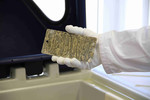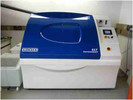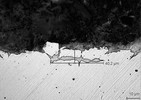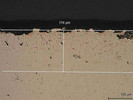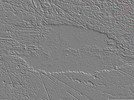Salt spray testing
(former DIN 50021)
Fundamentally speaking, the corrosion resistance of a material or of a protective anti-corrosion coating on it can be determined with the aid of a salt spray test in accordance with DIN EN ISO 9227.
During the testing the test specimens are placed in a chamber which is continuously misted with a 5% saline solution with a controlled pH value at a temperature of 35 °C. The mist hits the test specimens and covers them with a corrosive salt water film.
Typical test durations are, for example: 96 hours, 240 hours, 480 hours, 720 hours or also other test durations. The test duration depends on the expected corrosion resistance of the material system to be tested.
Once the salt spray testing has been concluded the test specimens are rinsed off with deionized water to remove any loosely adhering corrosion products. The corrosive attack of the tested material system is assessed visually or by the application of electrical or microscopy methods.
The corrosion resistance of, for example, a steel product that has been given protection against corrosion is derived from the time that a test specimen survives in the test without the base metal being corroded or red rust being visible.
Testing in accordance with DIN EN ISO 9227 NSS
In this test variation the pH value of the saline solution is kept neutral. The pH value is between 6.5 and 7.2. Such a test is carried out, for example, as part of the verification for wheel rim materials in accordance with ECE R124 Annex 5.
Testing in accordance with DIN EN ISO 9227 AASS
In this test variation the pH value of the solution is adjusted to a pH value of between 3.1 and 3.3 by adding acetic acid.
The following test version is used to test decorative (Cu + NiCr) coatings or anodic layers on aluminium:
Testing in accordance with DIN EN ISO 9227 CASS
In this accelerated variation acetic acid and copper chloride are added to the saline solution. This variation is used, for example, to test chromed plastic parts in the automotive sector.
Connection between salt spray testing and the working life of a component or a coating
It needs to be noted that it is fundamentally not possible to make conclusions as to the working life of the product to the customer or in actual use on the basis of the resistance to corrosion that had been determined (in hours) through the salt spray test. However, salt spray tests are very suitable for comparing materials and systems for protection against corrosion against one another.
Typical applications are:
- Determining the resistance to corrosion of untreated materials, steels or stainless steels, etc.
- Determination of the resistance to corrosion of surface-treated materials, plasma-nitrided steels, pickled and passivated stainless steels, etc.
- Determination of the resistance to corrosion of components with a coating to protect against corrosion, such as, for example
- simple paint systems, KTL or ATL painting, nano-paint coatings
- metallic coatings that were applied galvanically or chemically
- CVD or PVD coatings
RIO GmbH carries out salt spray tests in accordance with the following standards, among others:
ASTM B 117
Standard Practice for Operating Salt Spray (Fog) Apparatus
DIN 50021
Spray tests with different sodium chloride solutions; replaced by DIN EN ISO 9227
DIN EN 1670
Building hardware - Corrosion resistance - Requirements and test methods
DIN EN ISO 9227
Corrosion tests in artificial atmospheres -
Salt spray tests
DIN EN 60068-2-11
Environmental testing - Part 2: Tests;
Test Ka: Salt mist
DIN EN 60068-2-52
Environmental testing - Part 2: Test method
Test Kb: Salt mist, cyclic (sodium chloride solution)
ECE R124 Annex 5
Testing of corrosion incl. cross-cut adhesion test and simulated stone impact in accordance with ISO 565 (DIN EN ISO 20567-1)












